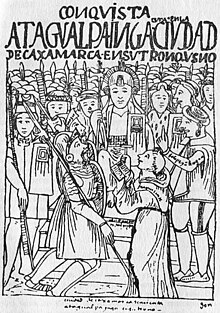You can help expand this article with text translated from the corresponding article in Italian. (March 2009) Click for important translation instructions.
|
Felipillo (or Felipe) was a 16th-century Amerindian interpreter who accompanied Spanish conquistadors Francisco Pizarro and Diego de Almagro on their various expeditions to Peru during their conquest of the Inca Empire. His real name is not known.
Biography

There is discrepancy between Spanish contemporary sources about Felipillo's place of birth. According to some of them, he was a native of Tumbez, but according to others, he was born in the region of Poechos, and was of Tallán ethnicity. An isolated version claims he was from the island of Puná. Felipillo learned Quechua in Tumbes from natives who spoke it as a second language, and he also learned basic Spanish from Pizarro's soldiers. He was later taken back to Panama by Pizarro.
On his return to Peru, Felipillo continued serving as a translator for the Spaniards as the conquest of the country carried its course, although historians agree that the interpretation provided by Felipillo was far from faithful or even helpful for the Spaniards. After Pizarro captured the Inca ruler Atahualpa during the Battle of Cajamarca in 1532, Felipillo served as the main translator for Pizarro and Atahualpa during their first meeting. According to Pedro Cieza de León, since Felipillo belonged to a rival tribe and was having an affair with one of Atahualpa's concubines, he deliberately translated Pizarro's messages inaccurately to the Inca king, and spread false rumors:
Atahualpa had as wives and concubines many principal Indian ladies, natives of the kingdom's provinces, most of them extremely beautiful and some very white and of exquisite figures. Felipillo, interpreter and wicked traitor, had fallen in love with one of them, so much so that he was desperate to have her. While the lord was alive, he did not find courage —by entreaty, threat, or promise— to gain her, but it seemed to him that if were to die, he would ask Pizarro for her or he would take her and she would be his. The camp was full of thieves, whom we call yanaconas —the name of a perpetual servant— so having such a design, had some conversations with them and other local Indians whom he understood because he was an interpreter and who were on bad terms with Atahualpa: they should spread the fictitious news that Indian warriors were coming from all parts, assembled on Atahualpa's orders to attack the Spaniards.
Felipillo later betrayed Almagro during his expedition to Quito. In another incident, Felipillo betrayed Almagro again during his expedition to Chile by secretly telling the local natives to attack the Spaniards since they only wanted their gold and urged them to attack them or run away. Some accounts say that when Almagro discovered Felipillo's treacherous motives and his confession about purposely misinterpreting Pizarro's message to Atahualpa, he ordered his soldiers to capture Felipillo and tear his body apart with horses in front of the region's Curaca.
Among Peruvians today, the word "Felipillo" has taken a meaning similar to "traitor."
See also
References
- Prescott, W. H., 2011, The History of the Conquest of Peru, Digireads.com Publishing, ISBN 9781420941142
- ^ Leon, P., 1998, The Discovery and Conquest of Peru, Chronicles of the New World Encounter, edited and translated by Cook and Cook, Durham: Duke University Press, ISBN 9780822321460
External links
- "Felipe" . Appletons' Cyclopædia of American Biography. 1900.
- Inca Empire
- Spanish conquest of the Inca Empire